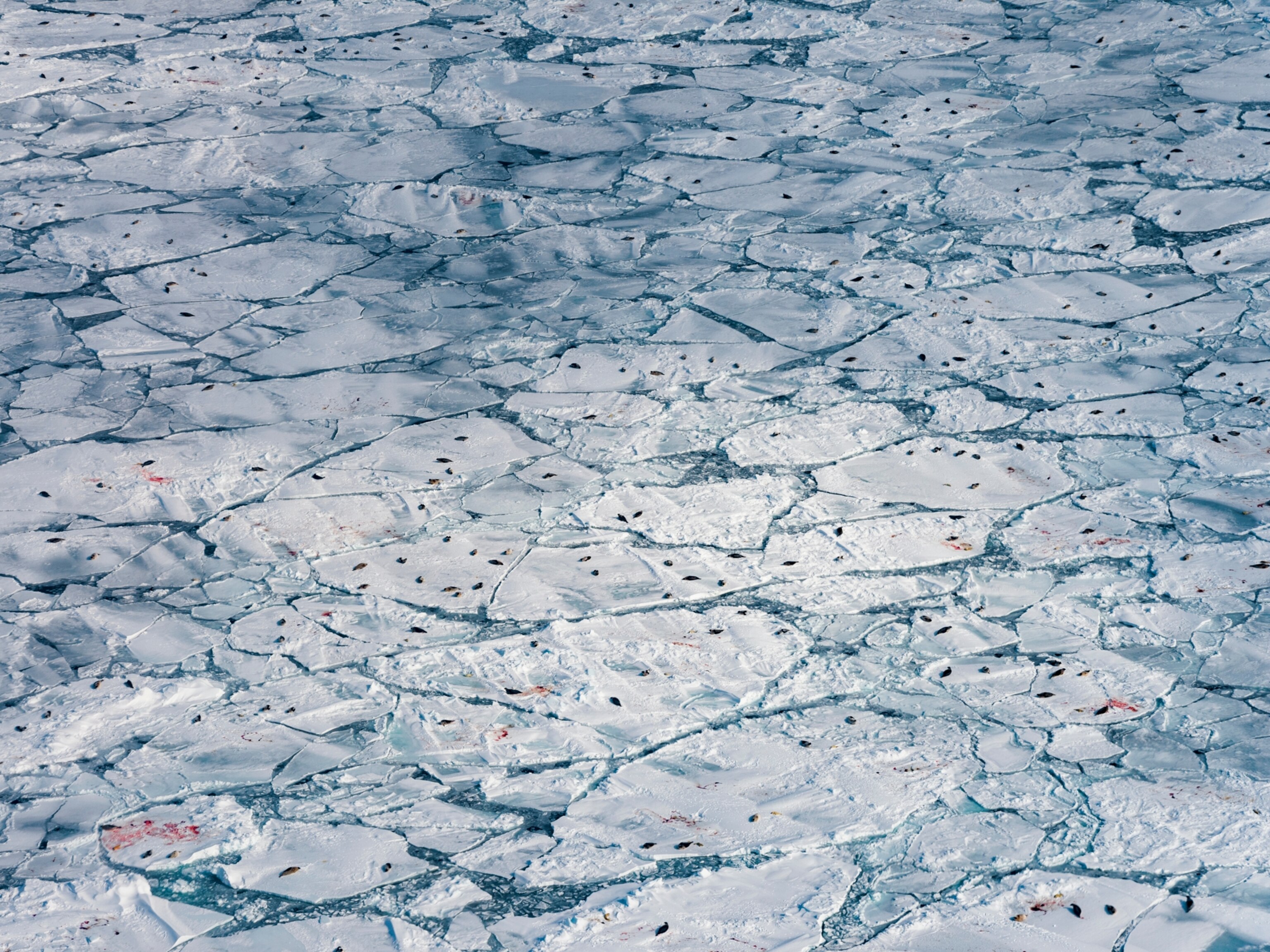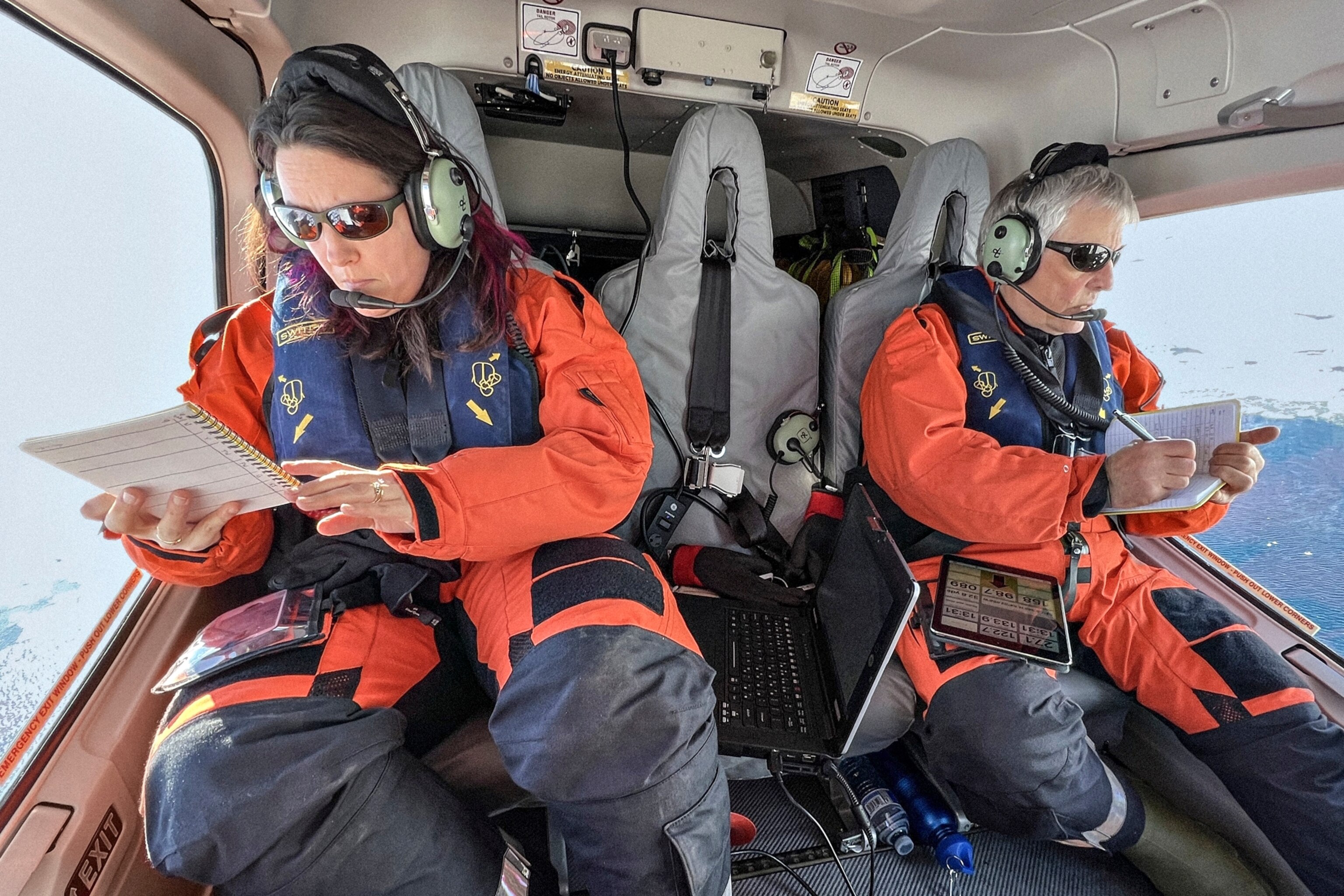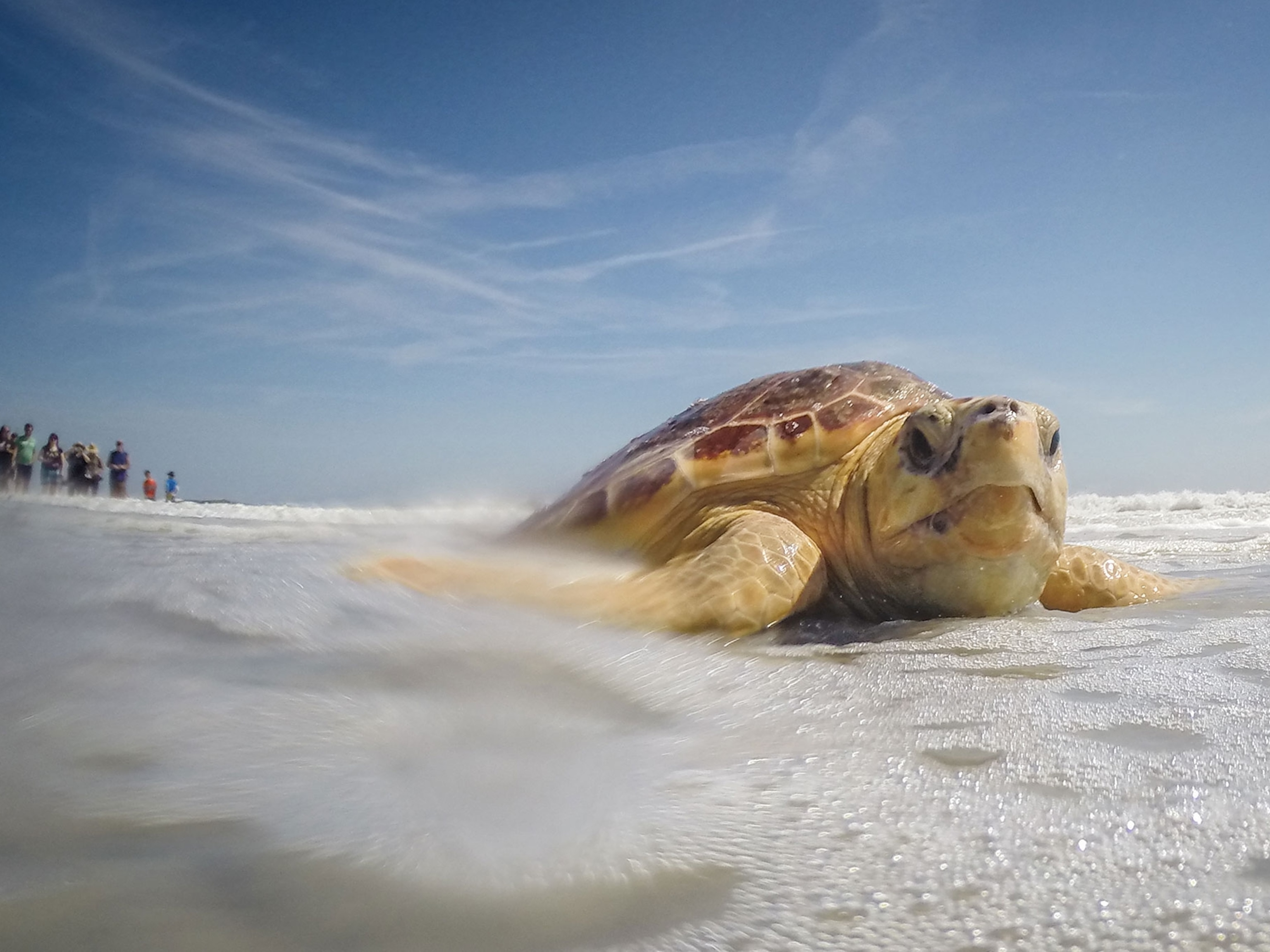
Meet one face of the climate crisis
Harp seals are born on sea ice, which is getting thinner every year. Scientist turned photographer Jennifer Hayes documents their fight for survival.
Diving beneath a white cathedral of ice, I could hear the shrill whistles, honks, and squeaks of harp seals.
They could easily have been mistaken for the sounds of a rainforest—except I was in the frigid waters of the Gulf of St. Lawrence. Around me, adult harp seals gracefully soared through their private underworld. On a ceiling of ice above us rested thousands of newborn pups.
I was in the Magdalen Islands, an archipelago in the gulf, in March 2011. Together with my partner, David Doubilet, I had set out to photograph harp seals as part of a comprehensive story on the marine ecosystem of the Gulf of St. Lawrence—an alcove of the North Atlantic Ocean—where the waters teem with life. Historically in winter, the gulf’s pack ice transforms into the southernmost whelping grounds for harp seals—an ice nursery for newborn pups.


“Come, we search for ice,” said Mario Cyr, our local guide. “If we find ice, we find seals.” He was right: A herd of pregnant females had located a loose patchwork of ice near Prince Edward Island, hauled out, and given birth. Our boat navigated into the ice, and we spent a week documenting harp seal behavior above and below the surface. The seal herd was spread among a windswept puzzle of small pans of ice surrounded by semifrozen slush. By day, the sun danced across an icescape dotted with harp seal mothers and pups with cloud-soft fur, obsidian eyes, and charcoal noses. At night a chorus of infant-like cries from the pups wafted through the hull of our boat as we slept.
Harp seals need to give birth on ice. Migrating from the Arctic at the end of August, they will search for sea ice in late February, when typically each pregnant female gives birth to a single pup. Mothers will nurse their young for the first two weeks of life, building up their fat reserves, and then abandon them on the ice when they leave to mate. The pups rely on their blubber to survive until they master swimming and how to capture their own food. To learn how to be a harp seal, the pups need time—and stable ice.
But winters in the Gulf of St. Lawrence are warming twice as fast as summers, at a pace of more than two degrees Celsius every hundred years, says Peter Galbraith, research scientist in physical oceanography at Fisheries and Oceans Canada (DFO). This means diminished sea ice cover and vanishing nursery options for pregnant harp seals in the gulf.
Scientists tend to talk about winters in the region as good ice years and bad ice years. Good ice years—characterized by colder winters and thick, wide-reaching ice cover—are becoming less frequent: Sea ice in the gulf has been deteriorating since at least 1995. More common now are bad ice years, triggered by mild winters that produce fragile, thin ice pans prone to collapse. Bad ice years can be devastating for harp seals. One of those was 2011.

On our last day in the gulf that March, a storm tore across the water, whipping it to froth and frenzy. We had made it to harbor and were off-loading our gear when Cyr gave us the news: The weak ice, around which we’d spent days immersed in the lives of harp seals, had been pulverized by the storm. Thousands of pups had perished. In an instant, the nursery became a memory that existed only in our pictures.
The pups’ deaths were a crystallizing moment for me—when climate change came frighteningly into focus, playing out in real time. As a scientist turned storyteller, I questioned what the future held for this species that requires ice to survive. On my drive home, I became intent on documenting harp seals as a face of the climate crisis and have returned to the gulf’s pupping grounds over and over again for the past decade.

What I’ve learned since from Garry Stenson and Mike Hammill, harp seal experts at the DFO: Having no ice in the Gulf of St. Lawrence may be better than poor ice. In its absence, harp seals swim farther and seek ice outside their traditional pupping grounds. But, they agree, if there is any ice at all, no matter how bad, the herd will stay and use it, even if it’s too thin to sustain pups. But as harp seals move north to colder, icier habitats, such as off Baffin Island, they may face a new threat: polar bears.
In March 2022, I joined Stenson and a large team aboard the Canadian Coast Guard ship Sir William Alexander. They were in the middle of a harp seal survey conducted every four to five years at an area called the Front, off the coast of Newfoundland and Labrador—the largest whelping ground for the Northwest Atlantic harp seal population by area and number of seals.



The coordinated efforts to survey the area require fixed-wing aircraft and ship-based helicopters. Beacons deployed in the seal patches help aerial surveyors count pups, assess their age, and track movement. It’s hard enough in a good year. But each survey is getting a little more difficult, says Stenson. The sea ice off Newfoundland and Labrador is slowly trending in a similar direction as ice in the Gulf of St. Lawrence. Early in the survey, a severe storm blew the ice offshore and broke it up as winds pushed surviving pups eastward, away from usual foraging areas. It was Stenson’s last survey before his retirement and his most challenging yet: “The ice is poorer, the winds are stronger, and the challenges are greater.”
As grim as the outlook seems to be, there is some hope. Harp seals can adapt, and to survive, they will follow the ice. Long term, Hammill and Stenson predict, seals may establish whelping grounds farther north. This month the seals will begin another pupping season in the Gulf of St. Lawrence. I’ll be there waiting—and hoping for good ice.

This story appears in the February 2024 issue of National Geographic magazine.
You May Also Like
Go Further
Animals
- This fungus turns cicadas into zombies who procreate—then dieThis fungus turns cicadas into zombies who procreate—then die
- How can we protect grizzlies from their biggest threat—trains?How can we protect grizzlies from their biggest threat—trains?
- This ‘saber-toothed’ salmon wasn’t quite what we thoughtThis ‘saber-toothed’ salmon wasn’t quite what we thought
- Why this rhino-zebra friendship makes perfect senseWhy this rhino-zebra friendship makes perfect sense
Environment
- Your favorite foods may not taste the same in the future. Here's why.Your favorite foods may not taste the same in the future. Here's why.
- Are the Great Lakes the key to solving America’s emissions conundrum?Are the Great Lakes the key to solving America’s emissions conundrum?
- The world’s historic sites face climate change. Can Petra lead the way?The world’s historic sites face climate change. Can Petra lead the way?
- This pristine piece of the Amazon shows nature’s resilienceThis pristine piece of the Amazon shows nature’s resilience
- 30 years of climate change transformed into haunting music30 years of climate change transformed into haunting music
History & Culture
- When treasure hunters find artifacts, who gets to keep them?When treasure hunters find artifacts, who gets to keep them?
- Meet the original members of the tortured poets departmentMeet the original members of the tortured poets department
- When America's first ladies brought séances to the White HouseWhen America's first ladies brought séances to the White House
- Gambling is everywhere now. When is that a problem?Gambling is everywhere now. When is that a problem?
Science
- Should you be concerned about bird flu in your milk?Should you be concerned about bird flu in your milk?
- Here's how astronomers found one of the rarest phenomenons in spaceHere's how astronomers found one of the rarest phenomenons in space
- Not an extrovert or introvert? There’s a word for that.Not an extrovert or introvert? There’s a word for that.
Travel
- This striking city is home to some of Spain's most stylish hotelsThis striking city is home to some of Spain's most stylish hotels
- Photo story: a water-borne adventure into fragile AntarcticaPhoto story: a water-borne adventure into fragile Antarctica
- Germany's iconic castle has been renovated. Here's how to see itGermany's iconic castle has been renovated. Here's how to see it
- This tomb diver was among the first to swim beneath a pyramidThis tomb diver was among the first to swim beneath a pyramid






